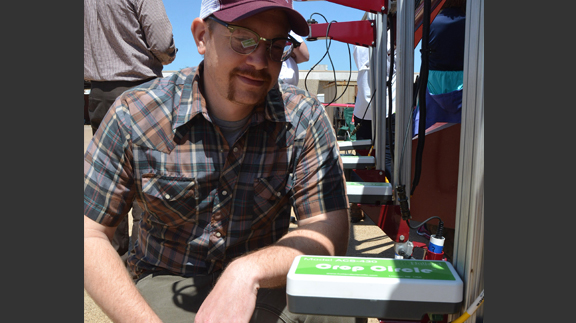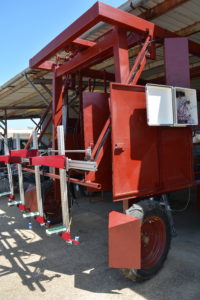Farm & Ranch
[AgriLife Today] AgriLife research remote sensing technology aims to solve critical crop diseases

By: Blair Fannin
- Writer: Blair Fannin, 979-845-2259, [email protected]
- Contact: Dr. Alex Thomasson, 979-458-3598, [email protected]
COLLEGE STATION – Sensor technology could possibly solve many challenges of crop production, and Texas A&M AgriLife Research faculty are aggressively attempting to find new solutions.
Dr. Alex Thomasson, an AgriLife Research biological and agricultural engineer, and Dr. Seth Murray, AgriLife Research corn breeder, both in College Station, and others are working jointly on several projects.
One project, an unmanned ground phenotyping system, provides data that can be used to aid decisions in breeding and production agriculture through techniques like conceptual modeling and spatial prediction, according to the scientists.
“We can also look at other characteristics like the drought tolerance of the plant. The data these machines collect will ultimately enable the breeder to make selections from the best varieties and to do so much quicker.”
Thomasson and other AgriLife and U.S. Department of Agriculture scientists are developing the ability to use remote sensing to detect and treat cotton root rot. Cotton Incorporated has been a strong supporter of this research, some of which is occurring at the Stiles Farm at Thrall.
“The cotton root rot project involves a lot of remote-sensing work to detect the locations of infection within individual fields,” he said. “It’s expensive for cotton farmers, not only the yield losses from the disease but the treatment to prevent it. It’s costing them about $50 an acre to treat the fields, but this research can save them a lot of money by enabling them to treat only the infected areas of a field. Some are trying to use satellite data to identify infected areas, but the image resolution is low. We’ve begun using UAVs (unmanned aerial vehicles), which give us images with extremely high resolution. We have the potential to see where each infected plant is so we can know exactly where to place fungicide in subsequent seasons.”
The remote-sensing research is related to a broader scope of research projects implemented by AgriLife Research. The Texas A&M Coordinated Agricultural Unmanned Aerial Systems project and Ground Vehicle Validation is a collaboration of more than 40 faculty members within the Texas A&M University System.
An unmanned ground phenotyping vehicle is being tested to collect real-time crop data. (Texas A&M AgriLife Research photo by Blair Fannin)
Led by AgriLife Research, the project also involves the Texas A&M Engineering Experiment Station, the Center for Autonomous Vehicles and Sensor Systems, and the Center for Geospatial Applications and Technologies, as well as businesses and farmers. The research centers on 1,400 acres of AgriLife Research fields near College Station where corn, cotton, sorghum and wheat, as well as peaches and perennial grasses are grown.
For more, visit http://bit.ly/1TZMBl1 .
-30-
Find more stories, photos, videos and audio at http://today.agrilife.org
Farm & Ranch
Managing Show Cattle Through The Winter

By Heather Welper
Husband and wife duo, Heather and Calvin Welper, are the Co-Owners and Operators or Two C Livestock, located in Valley View, Texas.
The pair’s operation has a show cattle focus where they raise and sell purebred heifers of all breeds and club calf Hereford steers.
When it comes to show cattle, the Welpers know a thing or two including how to prepare for the cold winter months and the Texas major show season run.
To read more, pick up a copy of the November edition of North Texas Farm & Ranch magazine, available digitally and in print. To subscribe by mail, call 940-872-5922.

Farm & Ranch
Double M Ranch & Rescue

By Hannah Claxton, Editor
As the sun rises each day, so do the dozens of mouths that Meghan McGovern is responsible for getting fed. Rather than the sounds of a rooster crowing, McGovern hears the bellows and bleats of a variety of exotic deer, the chortle of kangaroos, the grunts of water buffaloes, and the chirps of a lemur.
Nestled against the banks of the Red River, the Double M Ranch and Rescue, with its high game fences and deer sprinkling the landscape,s its in stark contrast to the surrounding ranches.
“Having deer is kind of like eating potato chips- you can never actually have just one,” said McGovern with a laugh.
McGovern has several herds to take care of- fallow deer, axis deer, water buffalo, goats, and bison. In smaller numbers, there’s also a few kangaroos, a lemur, a potbelly pig, a pair of zebras, a watusi, and a few horses.
To read more, pick up a copy of the November edition of North Texas Farm & Ranch magazine, available digitally and in print. To subscribe by mail, call 940-872-5922.

Farm & Ranch
Acorn Toxicity

By Barry Whitworth, DVM, MPH
With the prolonged drought, most pastures in Oklahoma end up in poor condition. With the lack of available forage, animals may go in search of alternative foods.
If oak trees are in the pastures, acorns may be a favorite meal for some livestock in the fall. This may result in oak poisoning.
Oak leaves, twigs, buds, and acorns may be toxic to some animals when consumed.
To read more, pick up a copy of the November edition of North Texas Farm & Ranch magazine, available digitally and in print. To subscribe by mail, call 940-872-5922.

-

 Country Lifestyles2 years ago
Country Lifestyles2 years agoScott & Stacey Schumacher: A Growth Mindset
-

 Country Lifestyles8 years ago
Country Lifestyles8 years agoStyle Your Profile – What your style cowboy hat says about you and new trends in 2017
-

 HOME8 years ago
HOME8 years agoGrazing North Texas – Wilman Lovegrass
-

 Outdoor10 years ago
Outdoor10 years agoButtercup or Primrose?
-

 Country Lifestyles5 years ago
Country Lifestyles5 years agoAmber Crawford, Breakaway Roper
-

 Country Lifestyles9 years ago
Country Lifestyles9 years agoJune 2016 Profile – The man behind the mic: Bob Tallman
-

 Equine1 year ago
Equine1 year agoThe Will to Win
-

 Country Lifestyles8 years ago
Country Lifestyles8 years agoDecember 2016 Profile, Rusty Riddle – The Riddle Way





